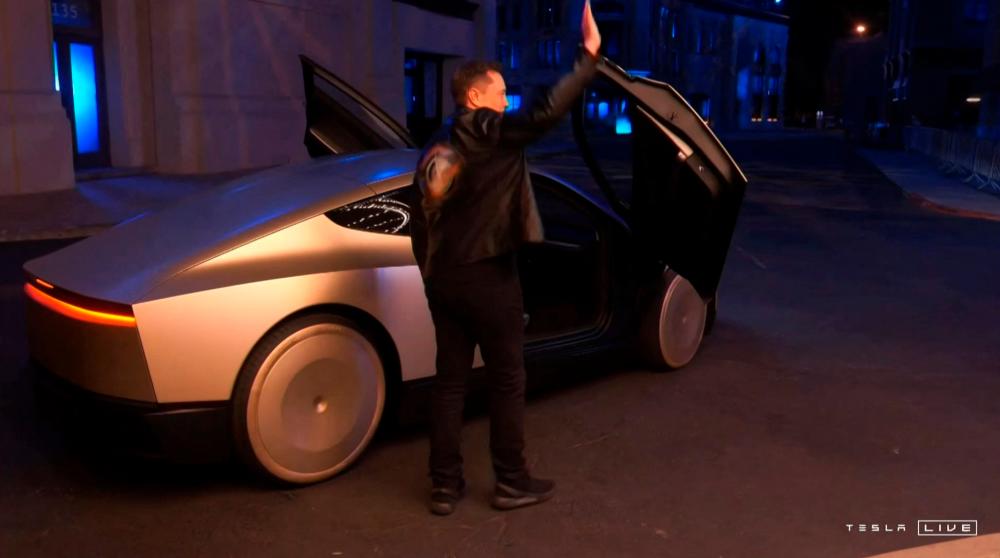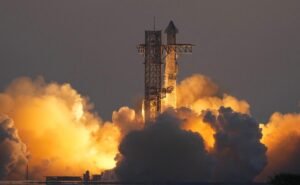
“Tesla’s Cybercab: A Game Changer in the Autonomous Vehicle Landscape”

Elon Musk has officially unveiled the Tesla Cybercab, a groundbreaking fully autonomous robotaxi designed to redefine urban transportation. This innovative vehicle was presented at the “We, Robot” event held at Warner Bros. Studios in California on October 11, 2024, marking a significant milestone in Tesla’s journey towards a future dominated by self-driving technology.
Key Features of the Cybercab
- Design and Structure: The Cybercab boasts a sleek, futuristic design reminiscent of the Cybertruck, featuring unique butterfly doors and a minimalist interior that accommodates two passengers. Notably, it lacks traditional driving controls such as steering wheels and pedals, emphasizing its fully autonomous nature.
- Technology: Equipped with Tesla’s latest AI-driven camera systems, the Cybercab aims to navigate urban environments without human intervention. This approach contrasts with other companies that often utilize Lidar technology for autonomous driving.
- Production Timeline: Musk announced that production is expected to commence before 2027, pending regulatory approvals for fully autonomous vehicles. The rollout of unsupervised Full Self-Driving (FSD) technology is anticipated in Texas and California in 2025, which is crucial for the Cybercab’s introduction.
- Pricing: The anticipated cost for the Cybercab is projected to be under $30,000, making it a competitive option in the emerging robotaxi market. However, analysts express skepticism about whether Tesla can meet this price point while maintaining quality and safety standards.
Challenges Ahead
Despite the excitement surrounding the Cybercab’s unveiling, several challenges loom:
- Regulatory Hurdles: Gaining approval for fully autonomous vehicles remains a significant obstacle, especially in states like Texas and California where regulations are still evolving.
- Market Viability: Experts have raised concerns about the practicality of a two-seater robotaxi in a market that typically favors larger vehicles for ride-sharing purposes. The limited seating capacity may restrict its appeal among consumers looking for more versatile transportation options.
- Competition: Tesla faces stiff competition from established players like Waymo and General Motors’ Cruise, which are already operating autonomous vehicles in various cities. Analysts question whether Tesla can catch up given its history of ambitious timelines that have often been delayed.

How does the Cybercab’s AI technology compare to other autonomous vehicles
The Tesla Cybercab introduces a unique approach to autonomous vehicle technology, setting itself apart from competitors like Waymo and Cruise. Here’s a detailed comparison of the Cybercab’s AI technology with other autonomous vehicles in the market.
AI Technology Overview
Tesla Cybercab
- AI System: The Cybercab utilizes computer vision and an end-to-end machine learning approach, which processes visual data directly into driving decisions without relying on additional sensors like Lidar. This method aims to simplify the vehicle’s design and reduce costs.
- Data Utilization: Tesla leverages extensive data collection from its fleet to continuously improve its AI algorithms, enhancing the vehicle’s ability to navigate complex environments autonomously ,
- Safety Claims: Musk asserts that the Cybercab will be significantly safer than human drivers, projecting that autonomous vehicles could be 10-20 times safer due to their ability to process vast amounts of driving data without fatigue or distraction
Competitors (Waymo, Cruise, etc.)
- Sensor Technology: Competitors like Waymo and Cruise typically employ a combination of Lidar, radar, and high-definition maps alongside camera systems. This multi-sensor approach is designed to create a more comprehensive understanding of the vehicle’s surroundings
- Complexity and Cost: The reliance on various sensors increases the complexity and cost of these vehicles. While this may enhance safety and reliability, it contrasts with Tesla’s strategy to keep the Cybercab simpler and potentially more affordable
- Operational Strategy: Other companies often focus on achieving Level 4 autonomy, where vehicles can operate independently in specific conditions but may still require human intervention in others. Tesla aims for full autonomy (Level 5), which would allow the Cybercab to operate anywhere without human oversight ,
Market Implications
Advantages of Tesla’s Approach
- Cost Efficiency: By eliminating Lidar and focusing on camera-based systems, Tesla aims to produce a more cost-effective robotaxi, projected to be priced under $30,000 . This could make autonomous ride-sharing more accessible.
- Simplicity in Design: The absence of traditional controls like steering wheels and pedals reflects a bold vision for future mobility, potentially streamlining user experience and operational efficiency
Challenges Ahead
- Regulatory Hurdles: Tesla faces significant regulatory challenges before it can bring the Cybercab to market. Approval for fully autonomous vehicles remains a contentious issue across various jurisdictions
- Public Perception and Trust: Given past incidents involving Tesla’s Autopilot system, public trust in the safety of fully autonomous vehicles is crucial. Competitors with proven track records may have an edge in gaining consumer confidence,

What are the main safety concerns associated with the Cybercab’s AI technology
The Tesla Cybercab, while promising significant advancements in autonomous driving technology, raises several safety concerns associated with its AI systems. Here are the main issues identified:
Main Safety Concerns
1. Technical Glitches and Reliability
- Accident Potential: Autonomous vehicles, including the Cybercab, face scrutiny over their ability to handle unexpected situations. Critics argue that even minor technical glitches could result in life-threatening accidents, particularly if the AI fails to respond appropriately to unusual traffic conditions or emergencies .
- Complexity of Real-World Scenarios: The challenge lies in programming AI to react as reliably as human drivers do, especially in complex urban environments where rapid decision-making is crucial
2. Data Dependency and Manipulation
- Data Poisoning: The Cybercab’s AI relies heavily on training data. If this data is manipulated or “poisoned,” it can lead to incorrect or unsafe driving decisions. Attackers could introduce malicious data that alters the AI’s behavior, making it perform unpredictably
- Input Manipulation: Similar attacks can involve misleading input data that could trick the AI into making erroneous decisions during operation
3. Lack of Transparency and Explainability
- Decision-Making Opacity: The algorithms driving the Cybercab may lack transparency, making it difficult for developers and regulators to understand how decisions are made. This opacity can lead to challenges in diagnosing failures or biases within the system
- Algorithmic Bias: If the training data contains biases, the AI could make unfair or unsafe decisions, disproportionately affecting certain groups or situations
4. Cybersecurity Vulnerabilities
- AI as a Target: The Cybercab’s systems could be vulnerable to cyberattacks aimed at manipulating its operational algorithms. Threat actors might exploit these vulnerabilities to gain control over the vehicle, posing risks not only to passengers but also to public safety
- Model Theft and Exploitation: Stolen AI models could be modified for malicious purposes, potentially leading to increased risks in both cybersecurity and physical safety
5. Regulatory and Compliance Challenges
- Regulatory Hurdles: The deployment of fully autonomous vehicles like the Cybercab faces significant regulatory scrutiny. Ensuring compliance with safety standards is crucial before widespread adoption can occur
- Public Trust Issues: Past incidents involving Tesla’s Autopilot system have raised concerns about public trust in autonomous technology. Gaining consumer confidence will be essential for the Cybercab’s acceptance .

HERE ARE SOME IMAGES 👇




Conclusion
The Tesla Cybercab represents a bold step into the future of autonomous transportation, promising innovative technology and a streamlined design. However, its deployment raises critical safety concerns that must be meticulously addressed. Issues related to technical reliability, data integrity, algorithmic transparency, cybersecurity vulnerabilities, and regulatory compliance pose significant challenges.As Tesla moves forward with the Cybercab, it will need to prioritize rigorous testing and validation to ensure that its AI systems can handle the complexities of real-world driving scenarios safely.
Discover more from
Subscribe to get the latest posts sent to your email.






